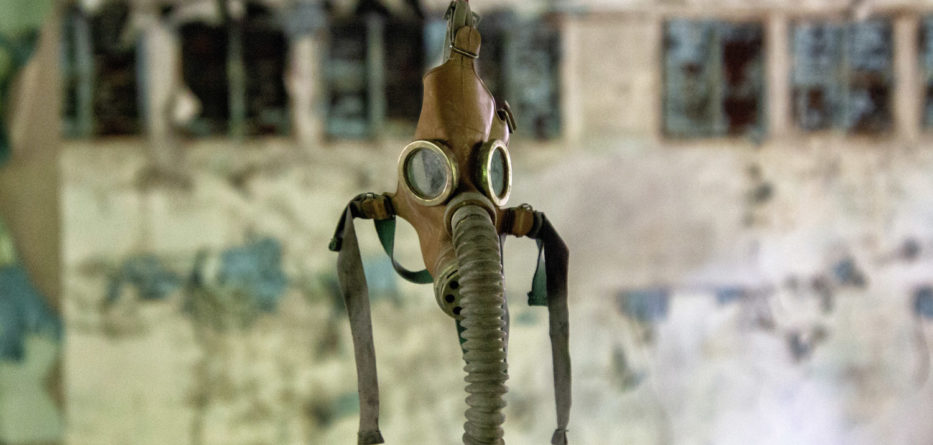Chernobyl – Visitors are given just five minutes to explore Chernobyl’s control room four, frozen in time since 26 April 1986 when a series of errors triggered the worst nuclear accident in history.
Before entering the dark and winding corridors leading to the epicenter of the disaster, they must first swap out their clothes for a sterilized suit.
Ukrainian authorities guarantee the visit is safe and insist that the maximum dose of radiation exposure in humans is 0.1 millisieverts, one thousand times less than what the International Commission on Radiological Protection (ICRP) considers harmful to health.
Children, pregnant and breastfeeding women are not allowed to enter the nuclear plant and all visitors must fill in several forms accepting a dozen strict security norms.
Before the tour starts, visitors must undergo a radiation exposure test under the watchful eye of two nurses.
During the entire guided tour, tourists must hang a radiation monitor around their necks.
As they approach the area around reactor number four, punters require a second dosimeter.
Throughout the visit there are a dozen checkpoints with radiation detectors that show the areas that must be scanned.
“The measurements cover practically the entire body, including the face, the back,” Yulia Marusich, Representative of the International Department of the Chernobyl nuclear power plant (NPP), told Efe.
It takes only five seconds until the machine reveals the result which reads: not contaminated.
Everyone who enters the Chernobyl nuclear power plant is required to wear head-to-toe protective gear, including socks, two pairs of trousers, a shirt, gloves, a cloth cap, a helmet and a mask that prevents people from inhaling radioactive particles.
After several years of working in Chernobyl, Marusich knows its maze of corridors like the back of her hand.
She is responsible for opening any door with a combination of keys, security codes and internal phone calls.
Everything is tightly controlled. A foot in the wrong direction can result in the immediate interruption of the tour.
Objects, like bags or cameras, left on the floors pose a risk of contamination that can require a decontamination process or may even be destroyed.
SURVIVORS AND WITNESSES
Only around 1,500 people who witnessed the nuclear accident first-hand are still alive, according to data from the Ukrainian National Chernobyl Museum.
Senior Lieutenant Aleksandr Logachev and Ilya Susnov were among hundreds of thousands ‘liquidators’ in charge of cleaning up the contaminated zone following the disaster.
Shortly after 3.00 am on 26 April, Logachev received an emergency call from the Chernobyl nuclear plant reporting the incident.
At the age of 27, he was the first person who drew up a detailed map showing the radiation levels in the plant.
“For four days and with hardly any sleep we examined both the central and the neighboring city of Pripyat, the urban center was most affected by radiation,” Logachev told Efe.
The map showed levels of up to 2,500 roentgens per hour in the rooms located close to Reactor 4. Roentgen is one of the standard units for measuring radiation. A level 400 roentgens per hour is considered lethal.
“We worked uncommunicated. Most of the time, almost blindly. The radio stopped working from 1,000 roentgens,” he added.
Logachev’s radioactive map was used by the authorities to justify the mass evacuation of the area, which took place two days after the first security measurements.
Ilya Susnov was 25 when he volunteered and worked for two months to build the first sarcophagus around the damaged reactor.
That initial shell was recently replaced since its structure began corroding and started releasing radioactive material.
It has reduced the level of gamma radiation around the center tenfold and was designed to be in operation for 100 years.
“I wanted to see it with my own eyes. I was fascinated by the idea of witnessing what had happened,” he recalled.
While working, Susnov was exposed daily to a dose of radiation ten times higher than normal.
Since 1986, he has received a pension equivalent to $11 a month as compensation.
TOURISM, ANTIDOTE TO FEAR
Ukrainian President Volodymyr Zelensky wants to reverse the negative image of Chernobyl.
“We have to turn our problem into an advantage,” Zelensky said during a recent visit to the nuclear plant.
He has signed a decree to boost tourism in the area to create a green corridor for active tourism.
Chernobyl has always attracted curious people.
The video game series “STALKER”, launched 13 years ago, awakened interest in Chernobyl laying the foundations for its status among tourists.
In the first-person shooter survival game, users are plunged into the zone of alienation around Chernobyl.
In the last 5 years alone, the number of tourists who flock to the morbid grounds has multiplied 12-fold.
The HBO miniseries “Chernobyl”, released last year, sparked a renewed interest in the disaster.
In 2019 a record 100,000 tourists visited the plant, according to the State Agency of Ukraine on Exclusion Zone Management.
The five episodes of Chernobyl “were one of the key milestones that gave us a push to extend the route to the control room number four at the plant,” Anton Povar, from the International Department of the Chernobyl NPP, said.
According to Konstantin Vlasov, head of Chernobyl Exclusive Tours, one of the twelve accredited tourist agencies operating in the exclusion zone, about half of its clients have watched the HBO miniseries.
“This is a unique type of tourism and we assume high risks.
“As a business, we have to deal with strict security checks, numerous rules and permits,” Vlasov said.
Slovak student Mona, 22, struggles to put into words how she feels after the visit.
“I feel very strong emotions here, I can’t help it. I think everyone should see this place,” she told EFE.
“Crying and nervous laughter are common reactions in my tours,” Marusich added.
According to senior lieutenant Logachev, HBO’s series shows things that didn’t happen, such as the presence of military with machine guns.
“It is a film, not a documentary,” he added.
Some Ukrainians, who represent around 25 percent of visitors, illegally enter the exclusion zone “for the purpose of extreme tourism”, avoiding all controls.
Marusich thinks that Chernobyl is not a place for extreme tourism.
“People lost everything here,” she explained.
“They lost their health, their life, their relatives, their children.
“It’s a place of a tragedy.”
As well as the current tours through the nuclear power plant, Chernobyl is preparing new routes by boat and helicopter.
Five water routes and three air routes have been already approved.
DISMANTLING CONTINUES
Tourists are not the only ones who every day enter the plant.
Engineer Vladimir (55), who didn’t want to give his family name, is part of the group of 2,800 operators who still work in it, most of them on the gradual dismantling, the storage of radioactive waste and general maintenance.
He has been in Chernobyl for two decades and the flow of tourists does not seem to bother him.
“I think that people would like to know truths. They would like to know what had happened here,” Marusich said.
Plant workers are now used to sharing the canteen with visitors.
Everyday employees commute to work by train from Slavutych, a purpose-built town created after the disaster to house displaced people and the liquidators.
On Thursdays, security protocols are reviewed, and evacuation drills take place although reactors no longer operate in the plant.
The plant has not been producing energy since 2000 but remains part of the Ukrainian electrical supply system.
Electrical power supply of the other four nuclear plants and 15 reactors of the country is managed from control room number 1.
Vladimir does 12-hour shifts in control room one.
“Many do not know, but from Chernobyl we make sure that electricity reaches all parts of Ukraine,” he says as he watches the panels with his two companions on duty.
Everything in the room is analog, from the buttons to control panels and meters. They will be completely dismantled by 2065.
At the time of the explosion, the four operational RBMK nuclear power reactors were supplying 10 percent of the then Ukranian Soviet Socialist Republic-s energy.
The plant was expected to expand its capacity with up to eight more reactors and would have become the most powerful in Europe.
For Soviet authorities, the reliability of these kinds of reactors was beyond doubt.
“This very type of reactors, RBMK reactors, they were so safe, they were so reliable that they couldn’t explode a priori,” Marusich added.
The explosion released 50 million curies of radiation into the atmosphere, the equivalent of 500 Hiroshima bombs.
The effects of radiation continue to affect the inhabitants of the surrounding areas of Ukraine, Belarus and Russia.






